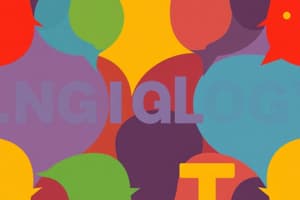Podcast
Questions and Answers
Young children find it difficult to master language skills.
Young children find it difficult to master language skills.
False (B)
B.F. Skinner proposed that language is learned through reinforcement.
B.F. Skinner proposed that language is learned through reinforcement.
True (A)
Noam Chomsky supported the behaviorist approach to language acquisition.
Noam Chomsky supported the behaviorist approach to language acquisition.
False (B)
There is no critical period for language acquisition.
There is no critical period for language acquisition.
Language development occurs consistently across different cultures and backgrounds.
Language development occurs consistently across different cultures and backgrounds.
As people age, the ease of acquiring new languages increases.
As people age, the ease of acquiring new languages increases.
All forms of communication can be classified as language.
All forms of communication can be classified as language.
The lexicon of a language refers to its grammar rules.
The lexicon of a language refers to its grammar rules.
Phonemes are the smallest units of sound in a given language.
Phonemes are the smallest units of sound in a given language.
Morphemes are formed by combining phonemes.
Morphemes are formed by combining phonemes.
Syntax refers to the meaningfulness of individual words in a language.
Syntax refers to the meaningfulness of individual words in a language.
Grammar allows for novel and creative communication of both concrete and abstract concepts.
Grammar allows for novel and creative communication of both concrete and abstract concepts.
Humans are unique among animal species primarily because of their ability to use gestures.
Humans are unique among animal species primarily because of their ability to use gestures.
Semantics plays a role in deriving meaning from morphemes and words.
Semantics plays a role in deriving meaning from morphemes and words.
Study Notes
Language Definition and Communication
- Language is a cognitive function comprising human sounds, written signs, and symbols to represent, process, store, and transmit verbal information.
- Communication exists in forms beyond language; many species use movements, postures, and vocalizations to interact socially.
- Language is often cited as the unique feature distinguishing humans from other species.
Components of Language
- Language comprises two main components: lexicon and grammar.
- Lexicon consists of the vocabulary of a language, encompassing its words.
- Grammar defines the set of rules used to create meaning from the lexicon.
- Phonemes are basic sound units forming words, varying across languages.
- Morphemes are the smallest meaning-conveying units in language, where phonemes can also act as morphemes (e.g., “I”).
- Semantics is the process of deriving meaning from words and morphemes.
- Syntax organizes words into coherent sentences, structured by grammatical rules.
Flexibility of Language
- Language enables the communication of diverse information, covering both concrete observations and abstract concepts.
- Humans can discuss personal thoughts, future plans, and a wide range of topics, showcasing the flexibility and complexity of language.
Language Development
- Mastery of language seems complex, but children often learn languages rapidly and easily.
- B.F. Skinner's behaviorist theory (1957) proposed language acquisition through reinforcement.
- Noam Chomsky (1965) criticized this view, suggesting language acquisition mechanisms are biologically inherent.
- Language development occurs without formal instruction and follows similar patterns across diverse cultures.
- There is a critical period for language acquisition; proficiency is highest during early childhood, decreasing with age.
Studying That Suits You
Use AI to generate personalized quizzes and flashcards to suit your learning preferences.
Description
This quiz explores the definition of language and its components, focusing on how language serves as a cognitive function unique to humans. It also addresses the various forms of communication found in other species, highlighting distinctions. Test your knowledge on the fundamental aspects of language and communication.




